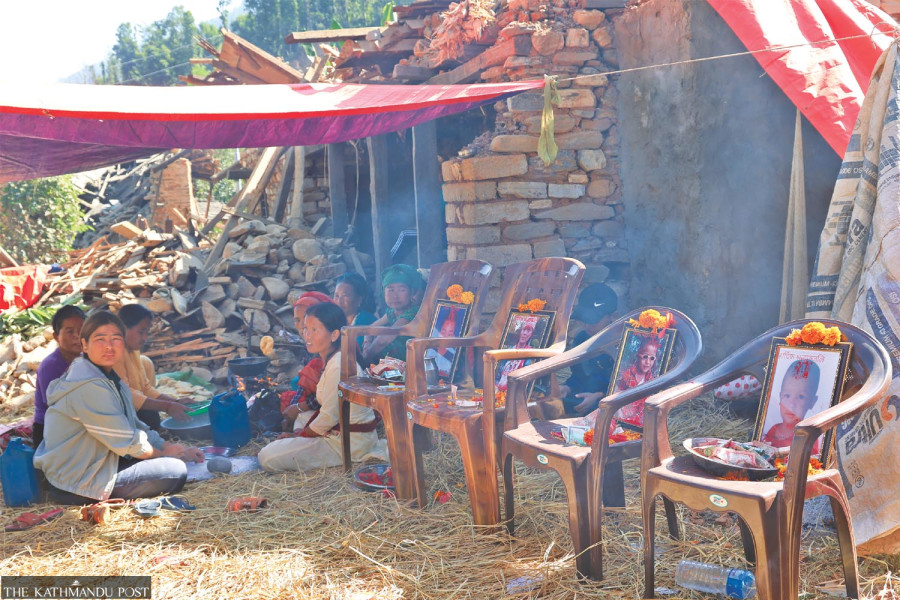National
Why Jajarkot earthquake is just a warning sign
As tectonic pressure builds, quakes are unavoidable. More dangerous are poor structures and unpreparedness.
Binod Ghimire
A 6.4 magnitude earthquake that devastated Jajarkot and West Rukum districts on November 3 killed at least 154 people in addition to injuring 364 others. Property worth billions of rupees was turned to rubble, with reports of 35,455 houses partially damaged and 26,557 completely destroyed. Despite being in an active seismic zone, strong earthquakes have not hit the western belt of Nepal for centuries. Seismologists have long warned of a strong tremor in the region at any time—and then there was last week’s earthquake.
Against this backdrop, the Post explains whether the Jajarkot earthquake was the strong one the experts were warning about and if there is the possibility of an even bigger one.
How strong was the Jajarkot earthquake?
As per the National Earthquake Monitoring and Research Centre, the Jajarkot earthquake with its epicentre at Ramidanda in the district measured 6.4 in the Richter scale, even though the US Geological Survey put it at 5.6. Its depth was around 15 kilometres. If the claim of officials is anything to go by, the November 3 earthquake was ‘moderate’ in intensity even though it claimed many lives and destroyed around Rs2 billion worth of properties.
Lok Bijay Adhikari, senior divisional seismologist at the centre who visited the earthquake-hit districts to study its impact, said that broadly earthquakes between magnitudes 5 and 6 are taken as ‘shallow’ while those within the range of 6 to 7 magnitude are ‘moderate’. Similarly, earthquakes measuring between 7 and 8, and 8 and 9, are considered ‘strong’ and ‘devastating’ respectively.
Why did even a moderate tremor lead to huge losses?
It is because of unsafe construction, according to experts. Man Thapa, an expert on disaster management, said earthquakes don’t kill people but poor structures do. “The experts have always warned of the possibility of big earthquakes in western Nepal. Yet, there was little in terms of preparations, which resulted in huge losses,” he told the Post. He said better preparedness could have greatly reduced the losses.
Thapa said last week’s tremor could be a warning for a higher magnitude quake. “The earthquake has given a strong message that we remain alert and well prepared,” he said.
Experts say while magnitude is one factor, there are others that determine the loss in a particular earthquake. Adhikari said there had been minimal loss in the epicentre Ramidanda while major destruction was caused in ridges and settlements built over river sediment.
“The higher the density of the ground, the quicker the waves pass. This means the settlement in a rocky area is the least affected. But the waves pass slowly through sandy areas, resulting in longer tremors. This causes more damage,” he told the Post. “Above all, weak infrastructures were responsible for most of the losses from the Jajarkot earthquakes. The stone and mud structures couldn’t resist even moderate jolts.”
Is there still a threat of a big earthquake?
Various studies have shown two tectonic plates meeting beneath the Himalayas along a fault line. The Indian plate is moving northward at around 45mm a year and pushing under the Eurasian plate. Huge energy is generated as the plate moves. There is an earthquake wherever that energy is released. Though there have been strong earthquakes in central and eastern Nepal, no such tremors have been felt in the western part of the country for over 500 years now.
Adhikari said the Jajarkot earthquake hasn’t averted an even bigger one. “However, it would be wrong to create a narrative that a big tremor will soon hit western Nepal. Yes, there is a possibility but no one can say when,” he said. An earthquake of 7 magnitude is 32 times stronger than one measuring 6.
Similarly, an earthquake of magnitude 8 produces 32 times more energy than one of magnitude 7. Likewise, an earthquake with 8 magnitude is over 1,000 times stronger than a magnitude 6 tremor. “Therefore, if there is a potential 8 magnitude earthquake in the west, there must be over 1,000 tremors of 6 magnitude to avert it. So I don’t think the Jajarkot earthquake has forestalled the possibility of larger tremors,” he said.
Several earthquakes of lower intensities have frequently hit the hill districts in the Sudurpaschim and Karnali provinces for the past few years. At least six people had lost their lives in an earthquake of magnitude 6.6 in Doti district in November last year. While several others were injured, they also lost their cattle and residences to the disaster. Just last month, on October 4, dozens of people were injured and several houses destroyed in a magnitude 6.3 earthquake in Bajura district. A woman died while 25 others were injured in a separate earthquake in January in the same district.
How can the country prepare for the worst?
Several shallow and moderate earthquakes have of late hit hill districts of Karnali and Sudurpaschim provinces. But some experts fear recent jolts, including the one in Jajarkot, are signs of much worse to come.
Better preparedness, therefore, is the only way to minimise the loss of lives and property, experts claim. Hari Darshan Shrestha, a professor at the Institute of Engineering under Tribhuvan University, said there is a practice of constructing sand and mud houses in the western hills, with little attention to earthquake safety.
“We can make these structures more resistant to earthquakes. There are different ways to do it. Binding them with gabion wires is one,” he told the Post. “This can be useful in reducing the loss of lives and property in the event of future disasters.”
Experts say Nepal’s response to the Jajarkot earthquake has shown it has developed its search and rescue capabilities. However, it lags in preparedness. Similarly, developing the capacity for relief and rehabilitation is what the country needs to focus on, they say.




 17.13°C Kathmandu
17.13°C Kathmandu














